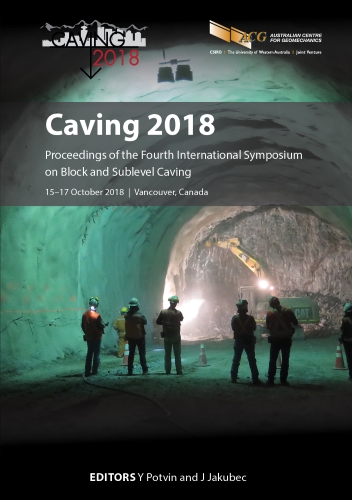Hang-up analysis and modelling for Cadia East PC1-S1 and PC2-S1

|
Authors: Castro, R; Cuello, D |
DOI https://doi.org/10.36487/ACG_rep/1815_15_Castro
Cite As:
Castro, R & Cuello, D 2018, 'Hang-up analysis and modelling for Cadia East PC1-S1 and PC2-S1', in Y Potvin & J Jakubec (eds), Caving 2018: Proceedings of the Fourth International Symposium on Block and Sublevel Caving, Australian Centre for Geomechanics, Perth, pp. 233-246, https://doi.org/10.36487/ACG_rep/1815_15_Castro
Abstract:
Cadia Valley operations is a gold–copper deposit located in Orange, New South Wales, Australia. Currently, two macroblocks are in production – PC1-S1 and PC2-S1 of Cadia East at undercut levels 4670 and 4475, respectively. The production rate during 2016 reached approximately 43 ktonne/day for PC1 and 19 ktonne/day for PC2. These macroblocks have implemented different variants of the block caving method and have different rock mass characteristics and depth. The PC1-S1 block was subjected to intensive preconditioning, hydraulic fracturing (from Gallery 5050) and DDE (blasting), for a column height of 400 m from the production level (4650 mRL). Finally, to propagate the caving effectively to surface, hydraulic fracturing was performed at 500 m below surface (maximum-depth hole). PC2-S1 was preconditioned only by hydraulic fracturing and is located 194 m below PC1. These two macroblocks are at different stages of maturity. PC1, a mature cave, has shown a fine fragmentation, which diminished notably as the cave back reached the surface in 2014. Consequently, there have been few observed hang-ups, resulting in a high production rate when compared to caving standards. On the other hand, PC2 has caving in progress and has shown a coarser fragmentation, and a large number of hang-ups. Therefore, prediction capabilities for hang-ups for PC2 is critical for planning purposes. In order to understand and model hang-ups for PC2, a BCRisk® model was built. BCRisk is a methodology to assess key gravity flow-related risks based on logistic regression. A BCRisk model of hang-ups delivers the probability (P) that the hang-up rate (HUR) would exceed 1 event/1,000 tonnes, that is P(HUR > 1). A univariate statistical analysis indicated that the key variables to be considered were the accumulated draw height (m), the uniformity draw index and the rock mass rating (RMR). The same analysis indicated that the different lithologies observed at PC2 were not a key variable. Each of the key variables has a significant and relative impact on P(HUR > 1). An increase of 10 m on the draw height decreases the probability of hang-ups by 26%, an increase of the RMR in 10 units increases the probability by 30%, while an improvement of draw uniformity index (by 30%) decreases the probability by 13%. The P(HUR > 1) was compared to the hang-ups database of PC2 (which consider hang-up events measured during 2016). The model showed a good fit to the data with an 81% accuracy at predicting events in terms of the number of drawpoints and the percentage of active area that could present hang-up issues.
Keywords: fragmentation, hang-up events, statistical modelling, mine data
References:
Arancibia, L, Castro, R, Valencia, M & Cifuentes, M 2018, ‘Modelling of early dilution entry using regression techniques’, in R Castro & Y Herazo (eds), Proceedings of UMining2018, Universidad de Chile Santiago, Santiago, pp. 65–81, in Spanish.
Brunton, I, Lett, J & Thornhill, T 2016, ‘Fragmentation prediction and assessment at the Ridgeway Deeps and Cadia East cave operations’, in C Carr & G Chitombo (eds), Proceedings of MassMin 2016, The Australasian Institute of Mining and Metallurgy, Melbourne, pp. 151–160.
Brzovic, A, Vallejos, J, Arancibia, E, Burgos, L, Delonca, A, Gaete, M & Barrera, V 2016, ‘Analysis and modelling of the fragmentation process – Case studies at El Teniente Mine’, in C Carr & G Chitombo (eds), Proceedings of MassMin 2016, The Australasian Institute of Mining and Metallurgy, Melbourne, pp. 305–310.
Hosmer, DW, Lemeshow, S & Sturdivant, RX 2013, Applied Logistic Regression, 3rd edn, John Wiley & Sons, New Jersey.
IBM 2018, SPSS, computer software, IBM, Armonk, https://www.ibm.com/analytics/spss-statistics-software
Kvapil, R 2008, Gravity Flow in Sublevel and Panel Caving – A Common Sense Approach, Luleå University of Technology, Luleå.
Laubscher, D 1994, ‘Cave mining – the state of art’, Journal of South African Institute of Mining and Metallurgy, vol. 94, no. 10, pp. 279–293.
Lett, J 2016, PC2-S1 Rock Mass Model - Summary Report, Newcrest Mining Limited, Melbourne.
Lett, J, Brunton, I, Capes, GW, Jäger, A, Mobilio, B, Rachocki, J, Sharrock, GB & Secheny, M 2016, ‘Undercutting to surface breakthrough – Cadia East Panel Cave (Stage 1)’, in C Carr & G Chitombo (eds), Proceedings of MassMin 2016, The Australasian Institute of Mining and Metallurgy, Melbourne, pp. 65–82.
Lett, J & Rossimel, C 2012, Cadia East Geotechnical Block Model for PC1-S1, Newcrest Mining Limited, Melbourne.
Lowther, RJ, Olivier, L, Lett, JL & Brunton, I 2016, ‘Implementation of a surface-based hydraulic fracturing program to successfully propagate a large cave through hard, competent near-surface rock masses to achieve breakthrough’, in C Carr & G Chitombo (eds), Proceedings of MassMin 2016, The Australasian Institute of Mining and Metallurgy, Melbourne, pp. 83–96.
Lopez, S 2016, Experimental Study of Hang-ups in Caving Mining, undergraduate thesis, University of Chile, Santiago, in Spanish.
Susaeta, A 2004, ‘Theory of gravity flow (part 2)’, in A Karzulovic and MA Alfaro (eds), Proceedings of MassMin 2004, Instituto de Ingenieros de Chile, Santiago, pp. 173–178.
© Copyright 2026, Australian Centre for Geomechanics (ACG), The University of Western Australia. All rights reserved.
View copyright/legal information
Please direct any queries or error reports to repository-acg@uwa.edu.au
View copyright/legal information
Please direct any queries or error reports to repository-acg@uwa.edu.au
